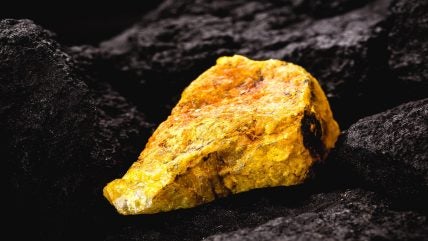The acquisition includes nine properties spanning approximately 6,500 hectares (ha)

Vancouver-based exploration company Atomic Minerals has finalised an asset purchase agreement to acquire a significant uranium land package near the Athabasca Basin in northern Saskatchewan, Canada.
The acquisition includes nine properties spanning approximately 6,500ha.
Atomic Minerals announced this plan on 5 February 2024 with a letter of intent.
The deal includes a payment of C$100,000 ($74,068) within five days of TSX Venture Exchange approval and the issuance of six million common shares in the capital of the company.
A second payment of C$100,000 is due on the six-month anniversary of the exchange approval.
Of the properties to be acquired, two are situated near known uranium deposits, with a third hosting a historic resource from 1957.
The property package features the Bleasdell Lake property, which has a historic resource estimated at 620,700 pounds of U3O8 (triuranium octoxide) across two zones.
Additionally, the Parks Lake property is located 3km south-east of the historic Rabbit Lake Mine and 2–4km east to north-east of Uranium Energy’s Horseshoe and Raven deposits.
The Pistol Lake property is entirely surrounded by Cameco territory and is situated just 600m north of its Sand Lake deposit.
Atomic Minerals CEO Clive Massey said: “With this Saskatchewan acquisition, Atomic now holds significant land positions in the two largest producing North American uranium districts, the Athabasca Basin and the Colorado Plateau.
“While the Bleasdell Lake historic resource may turn out to be the jewel, both Parks Lake and Pistol Lake hold significant exploration potential given Pistol Lake is mere metres away from Cameco’s 5,000,000-pound Sand Lake discovery.
“Our technical team is currently reviewing the data rooms for the various projects with the objective of generating drill targets for near-term diamond drilling.”
Updated study extends Niger mine life
07 March 2024
An updated feasibility study for Global Atomic's Dasa project has more than doubled the mine life with uranium production increasing by 55%. The company has also announced its fourth offtake agreement for the mine, where processing operations are expected to begin in late 2025 or early 2026.
.jpg?ext=.jpg) The ramp to the Dasa orebody, pictured in January (Image: Global Atomic)
The ramp to the Dasa orebody, pictured in January (Image: Global Atomic)The Dasa Project is defined in three phases. The 2024 Feasibility Study replaces the previous Phase 1 Feasibility Study, completed in late 2021. The new study extends mine life from 12 to 23 years, and includes a 50% increase in mineral reserves - the economically mineable part of the mineral resource - to 73 million pounds U3O8 (28,079 tU). Uranium production increases by 55% to 68.1 million pounds.
The company updated the mineral resource estimate for the project in May last year, when the conversion of resources from the inferred category saw indicated resources increase 50% to 109.3 million pounds U3O8.
Global Atomic President and CEO Stephen Roman said the new study has identified "significant improvements" in the project. "The payback period estimated in the 2024 study is expected to be 2.5 years, including recovery of amounts already spent," he said, adding that these estimated returns are "conservative", with opportunities to add value. "For example, there are 51.4 million pounds of Inferred Resources grading at 5,243 ppm in the Dasa deposit that could be converted to the Indicated category and brought into the mine plan," he said. "We expect to have full project financing in place soon and are on track for plant construction to commence in the second half of 2024 and plant commissioning to occur at the end of 2025."
Underground development of the mine began in late 2022, but was suspended following a military coup in the country the following year. Global Atomic continued to open up underground ore access and development of mine infrastructure, as well as site preparation for the processing plant, during a period of sanctions against the country that followed, developing an alternate shipping route through Togo and Burkina Faso for necessary supplies. Niger's neighboring ECOWAS nations lifted sanctions on Niger on 24 February this year, including reopening Niger's historic primary trade route to ocean shipping channels through the port of Cotonou in Benin.
"The government sees the Dasa Mine as playing a significant role in revitalising the central Agadez region of Niger," the company said.
New off-take agreement
Global Atomic also said it has finalised a Letter of Intent (LOI) for the sale of uranium from Dasa to a "strategic Europe-based nuclear power utility", subject to the successful conclusion of a purchase-sale contract. The LOI is "priced close to current market prices escalating each year".
The LOI represents the supply of 260,000 pounds U3O8 over a three-year delivery window beginning in 2026, and is the fourth such agreement signed by the company. It brings the company's total current committed volume up to 9.5 million pounds U3O8, representing revenue of up to USD770 million at current market levels, Global Atomic said.
Researched and written by World Nuclear News

No comments:
Post a Comment